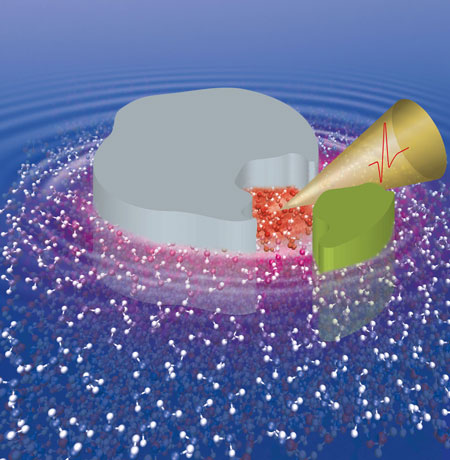| Nov 26, 2014 |
Classical enzymatic theory revised by including water motions
|
|
(Nanowerk News) Enzymes are macromolecular biological catalysists that lead most of chemical reactions in living organisms. The main focus of enzymology lies on enzymes themselves, whereas the role of water motions in mediating the biological reaction is often left aside owing to the complex molecular behavior. The groups of Martina Havenith (Cluster of Excellence RESOLV – Ruhr explores Solvation) and Irit Sagi (Weizmann Institue of Science, Israel) revised the classical enzymatic steady state theory by including long-lasting protein-water coupled motions into models of functional catalysis. The study has been conducted by integrating X-ray and terahertz based spectroscopies in conjunction with molecular dynamics simulations.
|
|
The researchers report their finding in the Proceedings of the National Academy of Science ("Enzymatic turnover of macromolecules generates long-lasting protein–water-coupled motions beyond reaction steady state").
|
 |
| Schematic diagram of the hydration funnel in an enzyme-substrate complex (the protein is depicted in grey, its binding partner in green, and the funnel in yellow). (Image: Havenith/Nibali)
|
|
Focussing on water-protein coupled motions
|
|
It is nowadays widely accepted that the water in complex biological processes plays a key role, however it is still not fully understood, due to the technical challenges associated with probing real-time changes in water dynamics during reaction. By integrating hard-core experimental technologies, such as terahertz spectroscopy, to X-ray absorption and analyses the researchers measured changes in the coupled protein-water motions during enzymatic reaction.
|
|
In addition, by means of molecular dynamics simulations, they could provide atomistic detail of the underlying mechanism. The investigated enzyme belongs to the family of the metalloproteinases, involved in the degradation of extracellular matrix proteins.
|
|
A new biological phenomenon
|
|
Using this integrated approach, the authors revealed a new biological phenomenon, in which water motions do not follow the classical enzymatic theory, but generate long-lasting protein-water motions that last longer than a single catalytic cycle. They observe the formation of a “hydrogen funnel” towards the molecular recognition site. The motions of the water are then adapted to the motions of the substrate which seems to be critical for binding, explains Prof. Dr. Martina Havenith-Newen.
|
|
Furthermore, this new phenomenon has been shown to depend on the binding partner, being the optimized molecular architecture of a binding partner critical for water-mediated effective binding. To conclude, altogether these observations revise the classical theory of enzymatic catalysis by including long-lasting protein-water coupled motions into models of functional catalysis.
|

